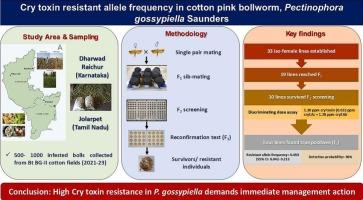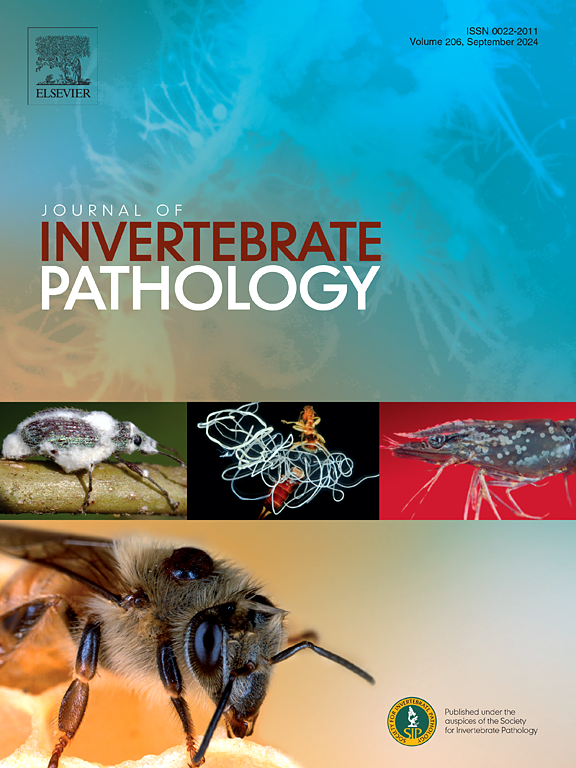南印度棉铃虫Pectinophora gossypiella Saunders种群抗Bt cry毒素等位基因频率高。
IF 2.4
3区 生物学
Q1 ZOOLOGY
引用次数: 0
摘要
表达苏云金芽孢杆菌(Bacillus thuringiensis, Bt)毒素的转基因棉花种植者对避难种植的不遵守是导致对Bt毒素Cry1Ac和Cry2Ab产生抗性以及在印度几个棉花种植区爆发粉红棉铃虫Pectinophora gossypiella的主要因素。本研究估计了南印度棉蚜群体对Bt Bollgard II®棉产生的Cry1Ac + Cry2Ab毒素的抗性等位基因频率。在33个已建立的同雌家族中,有19个产可育卵,达到F1代,其中10个在F2筛选中存活。此外,4个同雌家系的个体在F3代的再确认试验中幸存下来,以消除抗性的假阳性线。这四个家族是携带抗哭毒素等位基因的真正阳性。Cry1Ac和Cry2Ab毒素抗性等位基因的频率估计为0.059,表明携带Cry1Ac和Cry2Ab毒素抗性等位基因的个体相对较高。本研究证实了在印度南部棉棉棉蚧种群个体中存在高频率的抗性等位基因。棉田棉棉棉单胞虫类似暴发的情况强调了在害虫综合治理框架内开发和实施替代技术的迫切需要。目前的估计为监测棉铃虫群体抗性等位基因频率提供了有价值的基线数据。本文章由计算机程序翻译,如有差异,请以英文原文为准。

High levels of Bt cry toxin resistant allele frequency in South Indian populations of cotton pink bollworm, Pectinophora gossypiella Saunders (Gelechiidae: Lepidoptera)
The lack of compliance with refugia planting by growers of transgenic cotton expressing toxins from Bacillus thuringiensis (Bt) is a major factor contributing to the development of resistance to Bt toxins Cry1Ac and Cry2Ab and outbreak of pink bollworm, Pectinophora gossypiella in several cotton growing regions of India. The present study estimated the resistant alleles frequency in South Indian populations of P. gossypiella against Cry1Ac + Cry2Ab toxins produced by Bt Bollgard II® cotton. Among the 33 established isofemale families, 19 laid fertile eggs and reached the F1 generation, of which 10 survived the F2 screen. Further, individuals from four isofemale families survived the reconfirmation test at the F3 generation, which was conducted to eliminate false-positive lines for the resistance. These four families are the true positives for carrying Cry toxin resistance alleles. The frequency of Cry toxin resistance alleles was estimated at 0.059, indicating a relatively high prevalence of individuals carrying resistant alleles for both Cry1Ac and Cry2Ab toxins. The present study affirms the existence of a high frequency of resistance alleles in individuals of P. gossypiella populations collected from South India. The outbreak-like situation of P. gossypiella in cotton fields underscores the urgent need for developing and implementing alternative technologies within an Integrated Pest Management (IPM) framework. The present estimates provide valuable baseline data for monitoring resistance alleles frequency in pink bollworm populations.
求助全文
通过发布文献求助,成功后即可免费获取论文全文。
去求助
来源期刊
CiteScore
6.10
自引率
5.90%
发文量
94
审稿时长
1 months
期刊介绍:
The Journal of Invertebrate Pathology presents original research articles and notes on the induction and pathogenesis of diseases of invertebrates, including the suppression of diseases in beneficial species, and the use of diseases in controlling undesirable species. In addition, the journal publishes the results of physiological, morphological, genetic, immunological and ecological studies as related to the etiologic agents of diseases of invertebrates.
The Journal of Invertebrate Pathology is the adopted journal of the Society for Invertebrate Pathology, and is available to SIP members at a special reduced price.

 求助内容:
求助内容: 应助结果提醒方式:
应助结果提醒方式:


